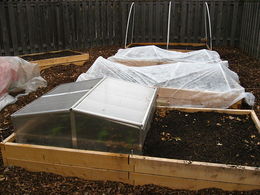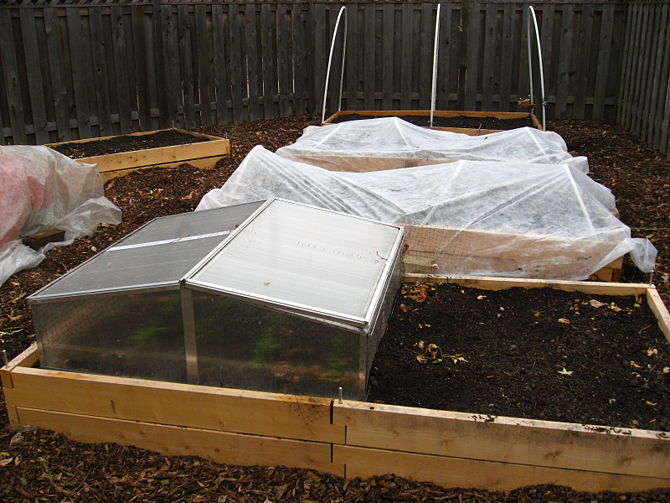Protecting Plants from the Cold
If your weather is a bit too cold or your plants a bit too tender, there are things you can do to help your garden through the winter. It all depends on how tender the plants are, how cold the weather is, how long it will be cold out, and how much energy and trouble you want to spend. For some combinations of climates and plants, no amount of extra care will keep them growing, but in many cases, a bit of extra care can bridge the gap.
This is the simplest, lowest-effort choice. Learn your which growing zone you are in (if your country has such a classification system; the US system is coordinated by the USDA) or at least your likely low and high temperatures for the year and choose plants that can withstand those temperatures. Some plants may die back, lose their leaves, or otherwise go dormant in winter, so take the time to know how plants that are well adapted to your climate handle it. The disadvantage to this approach, of course, is that it limits your selection of plants.
- Annuals are plants that die back each year and must be replanted if they do not reseed themselves. In colder climates, some perennial plants may be grown as annuals if they would otherwise not survive the winter. The growing season of some annuals may be extended with shelters or by starting the plants indoors or in a greenhouse.
- Perennials are plants that continue growing from one year to the next. For these, you will need to learn what, if any, additional care they require to survive the winter.
- Talk to the people at your favorite nursery about what to expect from a plant during winters in your area. Also ask where to plant and how to care for a plant before you purchase it.
- Look for varieties and cultivars of plants suited to your climate. Did you know that there are citrus trees bred to better withstand the cold? Did you know that there's a tomato cultivar called 'San Francisco Fog'?
2. Plant tender plants where they have some shelter and warmth. Sometimes, an alley out of the wind, the side of a house, or even a nearby path or sidewalk (to soak up and store some heat from daytime) can be enough to help a plant through the cold. Make a sun chart to see which parts of your garden get the most sunlight (just remember that sunlight will reach different parts in the winter than in the summer). Also remember that if a plant faces the morning sun, the rapid defrosting can cause the cell walls to rupture.
3. Throw an old blanket, drop cloth, or tarp over tender plants. If you need to protect your plants from a small number of especially cold nights, a simple shelter such as an old blanket may be enough. Take it off during the day so that the plants can get light and air. You may need to weigh or tie down the cloth so that it doesn't blow away.
4. Bring the plants indoors. If you can, carry or wheel the plants into a garage, sun room, greenhouse, or shed. Outdoor plants may not be at their best indoors, since they won't necessarily get enough light, but they may make it long enough to survive through the winter. For certain tender plants in cold winters, you may also be able to overwinter them by digging up the roots at the right time and storing them correctly indoors.
5. Build a cold frame or greenhouse.
- Build a simple, temporary cold frame by bending slender metal rods into loops and sticking the ends into the ground across a garden row. Then, place a length of clear plastic sheeting over the loops so that it encloses the plant.
- Build a somewhat more permanent cold frame by hinging a window or storm window to one side of an open-bottomed box built from scrap lumber.
- Build a PVC Hoophouse
- Make sure the plants in your greenhouse or cold frame receive adequate ventilation. Think about how warm the inside of your car gets on a sunny day. If daytime temperatures are warm, open up to allow air to circulate. If you don't, you could overheat your plants or build up too much moisture inside.
6. Use mulch. Mulch acts as an insulator, so mulch can protect plants, especially from wide swings in temperature. Sometimes the cold temperature is not what damages the plant. It's the freeze/thaw cycle affecting the soil and causing it to "heave" the plant. Or, the frozen soil can prevent the plant from drawing up water and it can die from lack of moisture. Consult a garden book about the particular plants you are growing. Some will tolerate this approach better than others. Mulch applied fairly thickly over the soil will insulate the roots. Certain plants, such as roses and strawberries, may be overwintered by covering them completely with a clean mulch.
- Insulation works both ways. It can prevent the soil from cooling off too quickly, but it can also prevent it from warming up promptly when the time comes. You may wish to rake it back away from the plants as spring starts to warm up.
7. Water. Don't do this if you expect a hard freeze, since it could backfire, but to protect against a little frost, a generous watering can help to retain some of the day's heat into the night.



